Charles E W Bean, Diaries, AWM38 3DRL 606/260/1 - 1916 - 1930 - Part 12
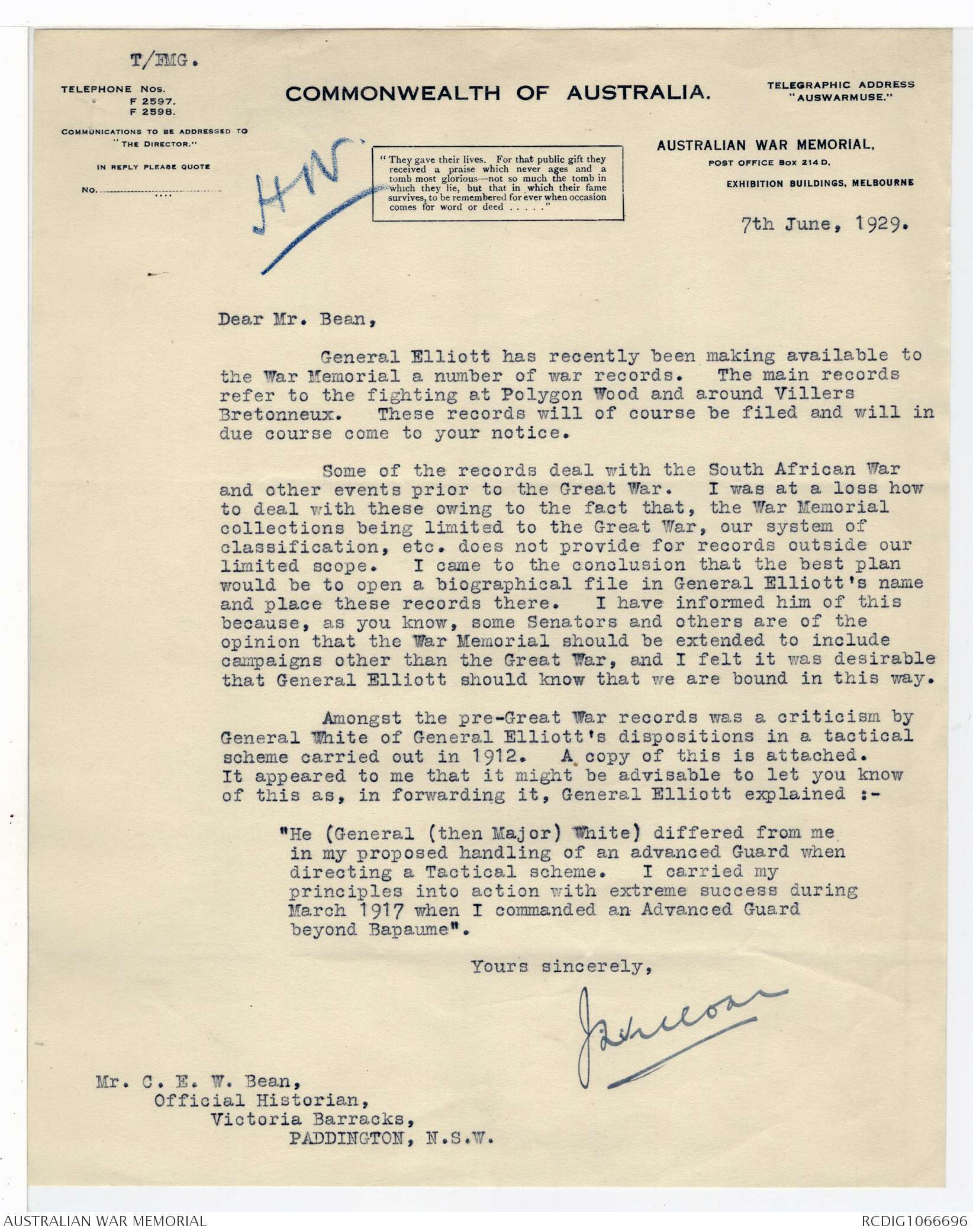
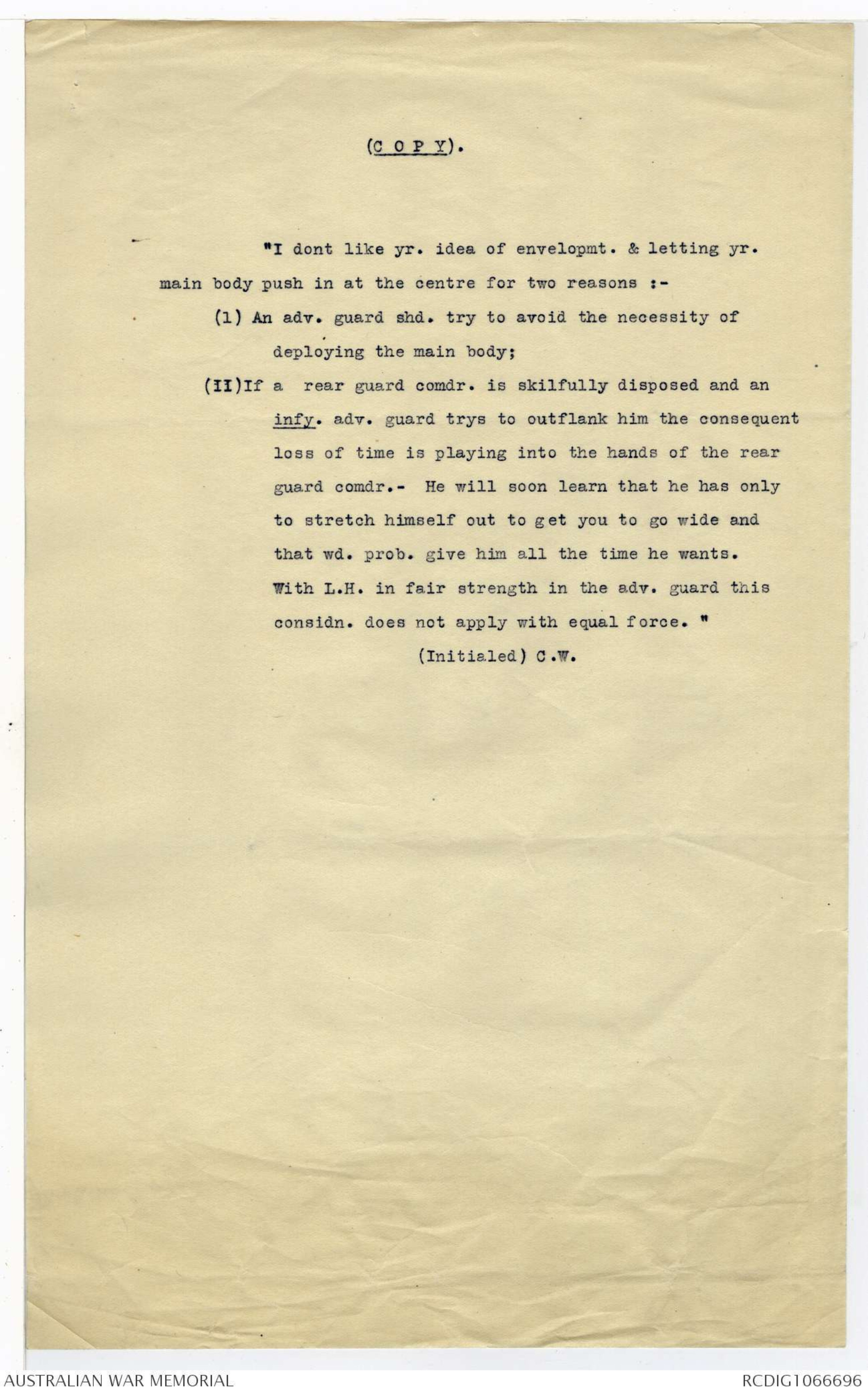
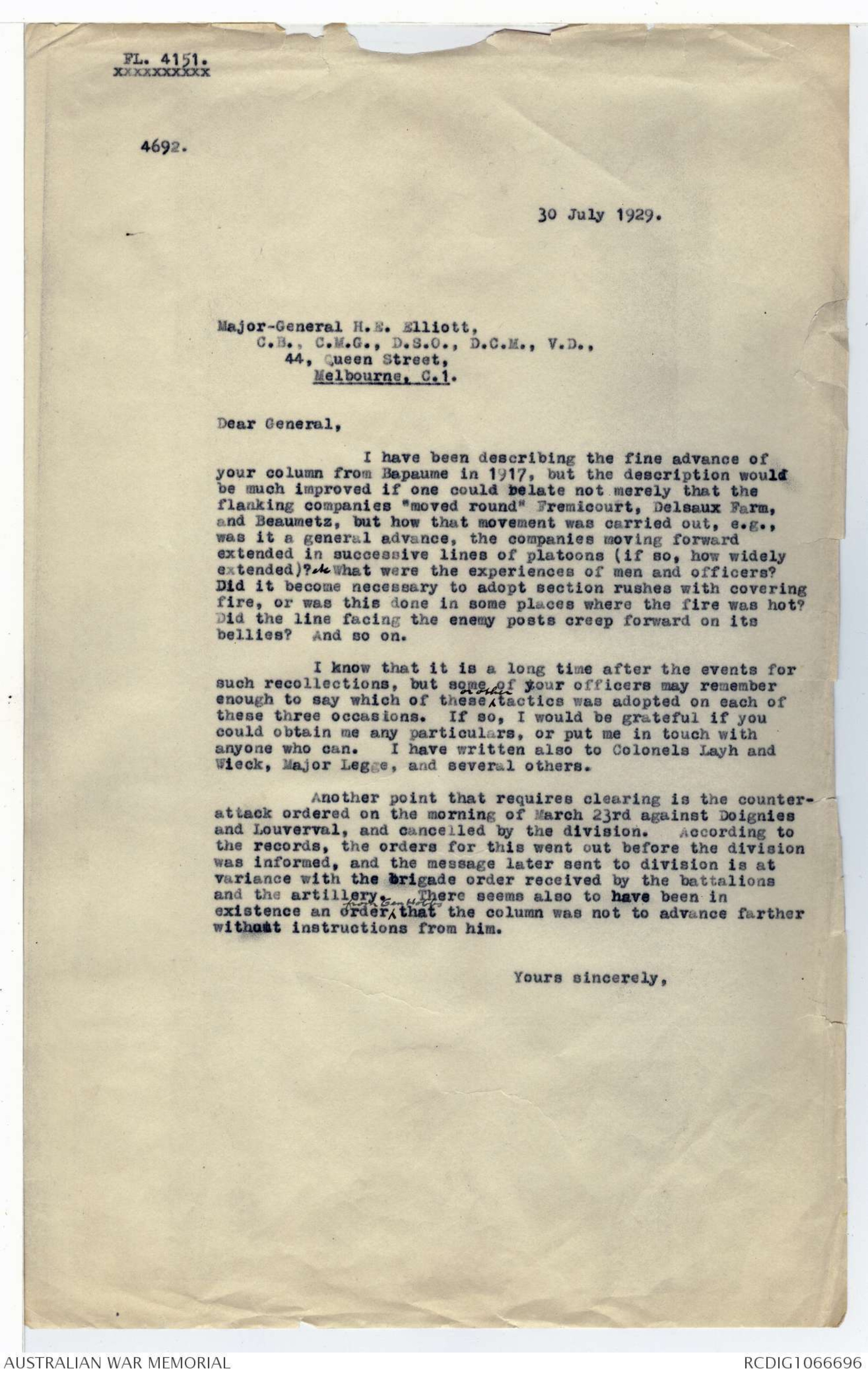
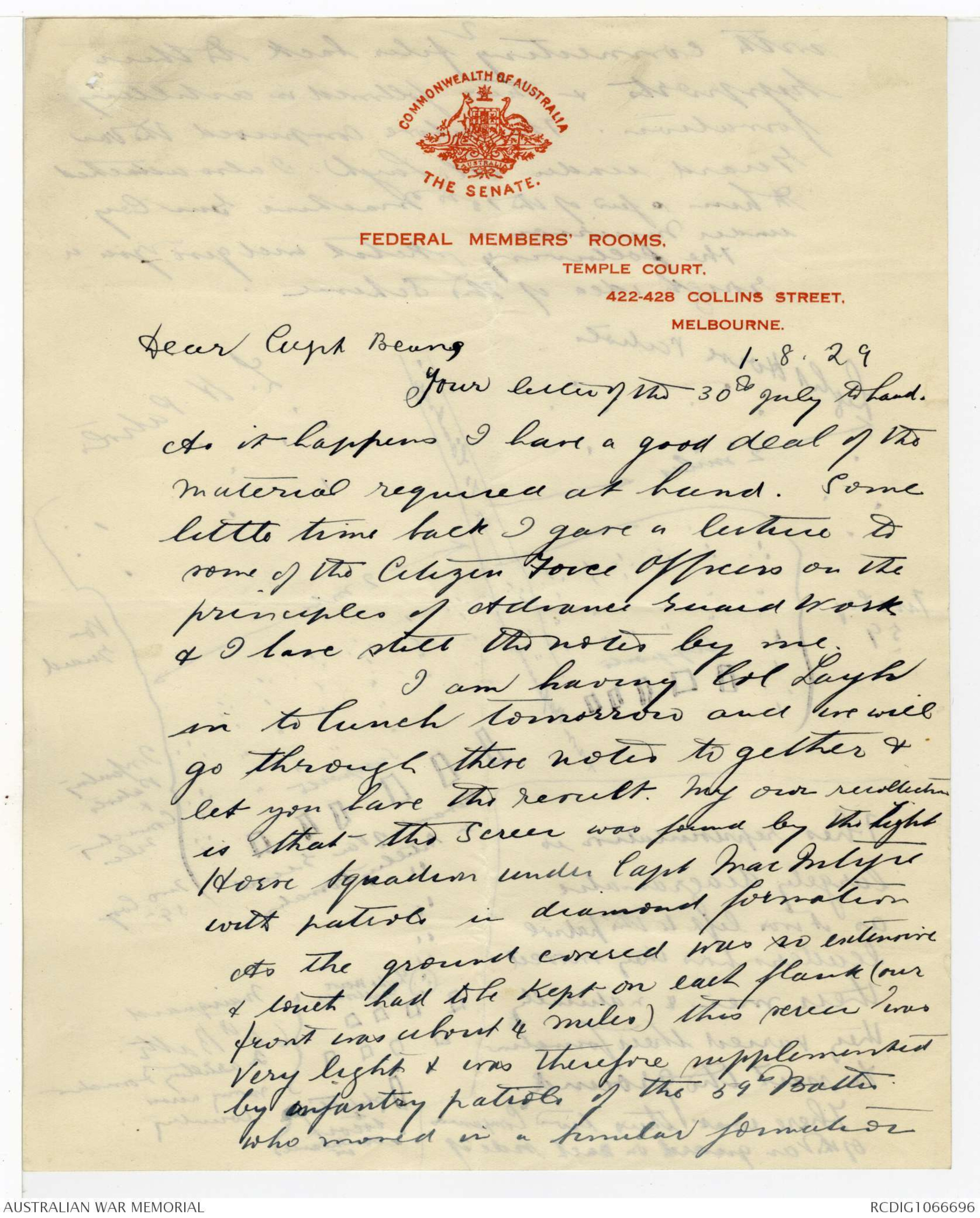
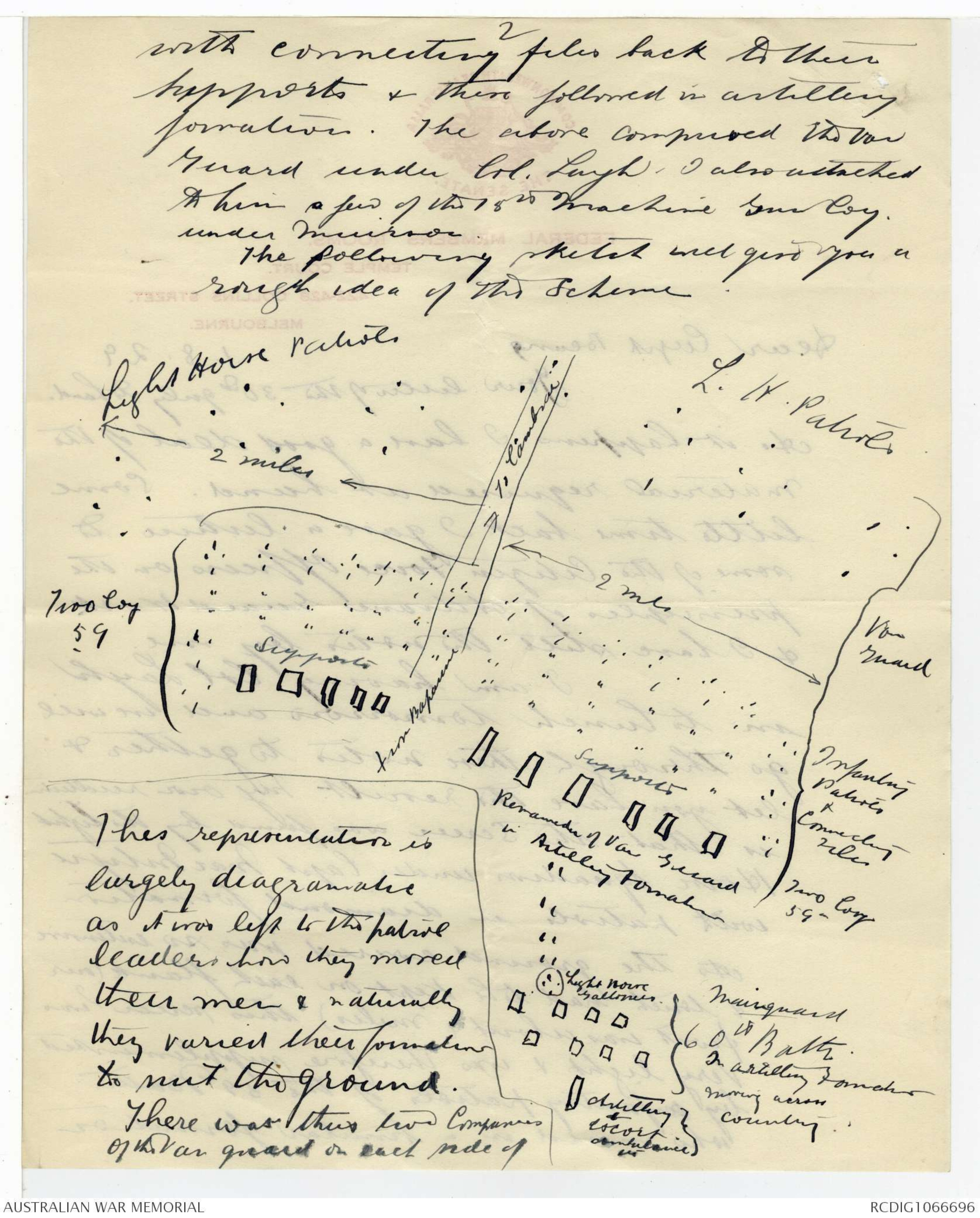
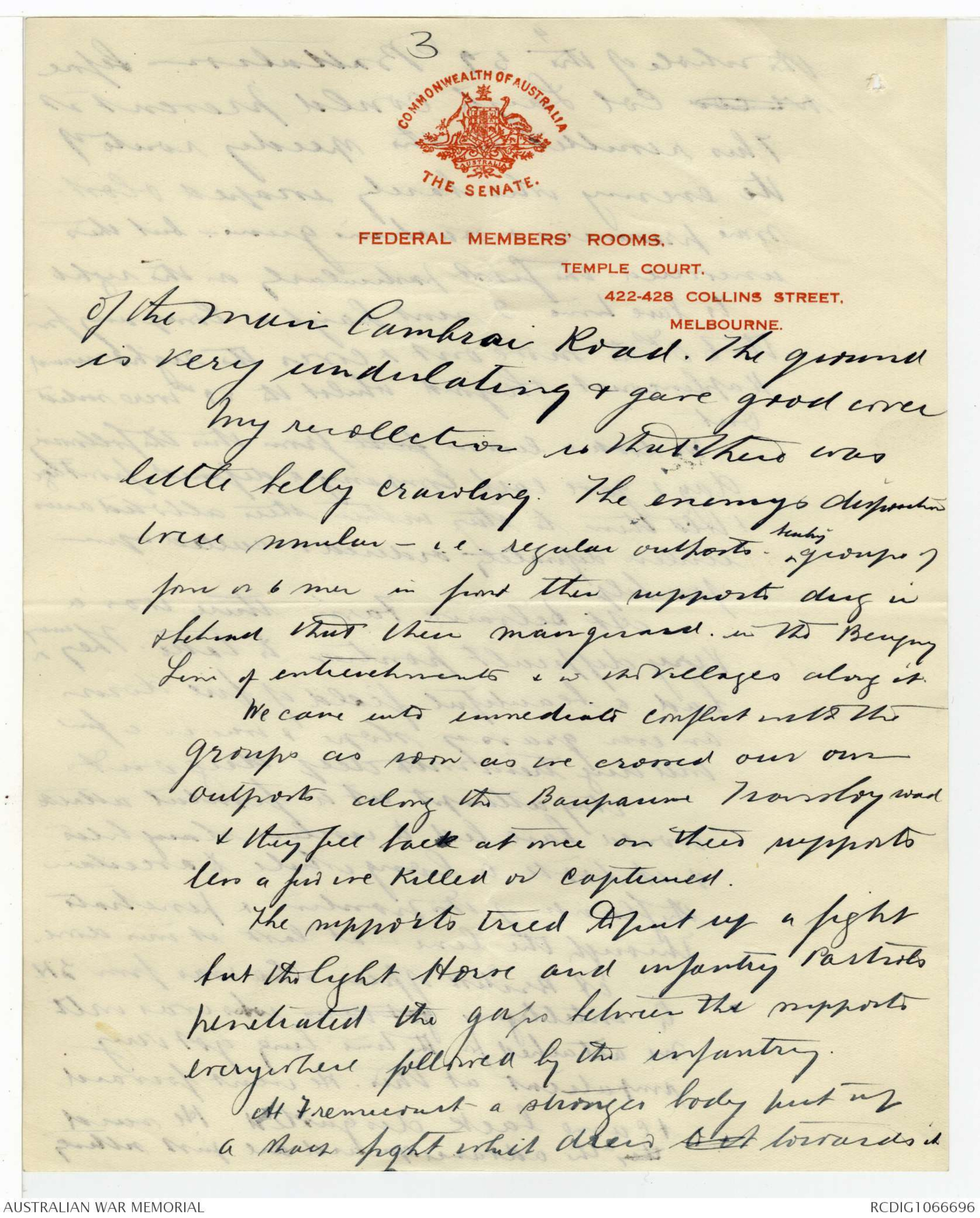
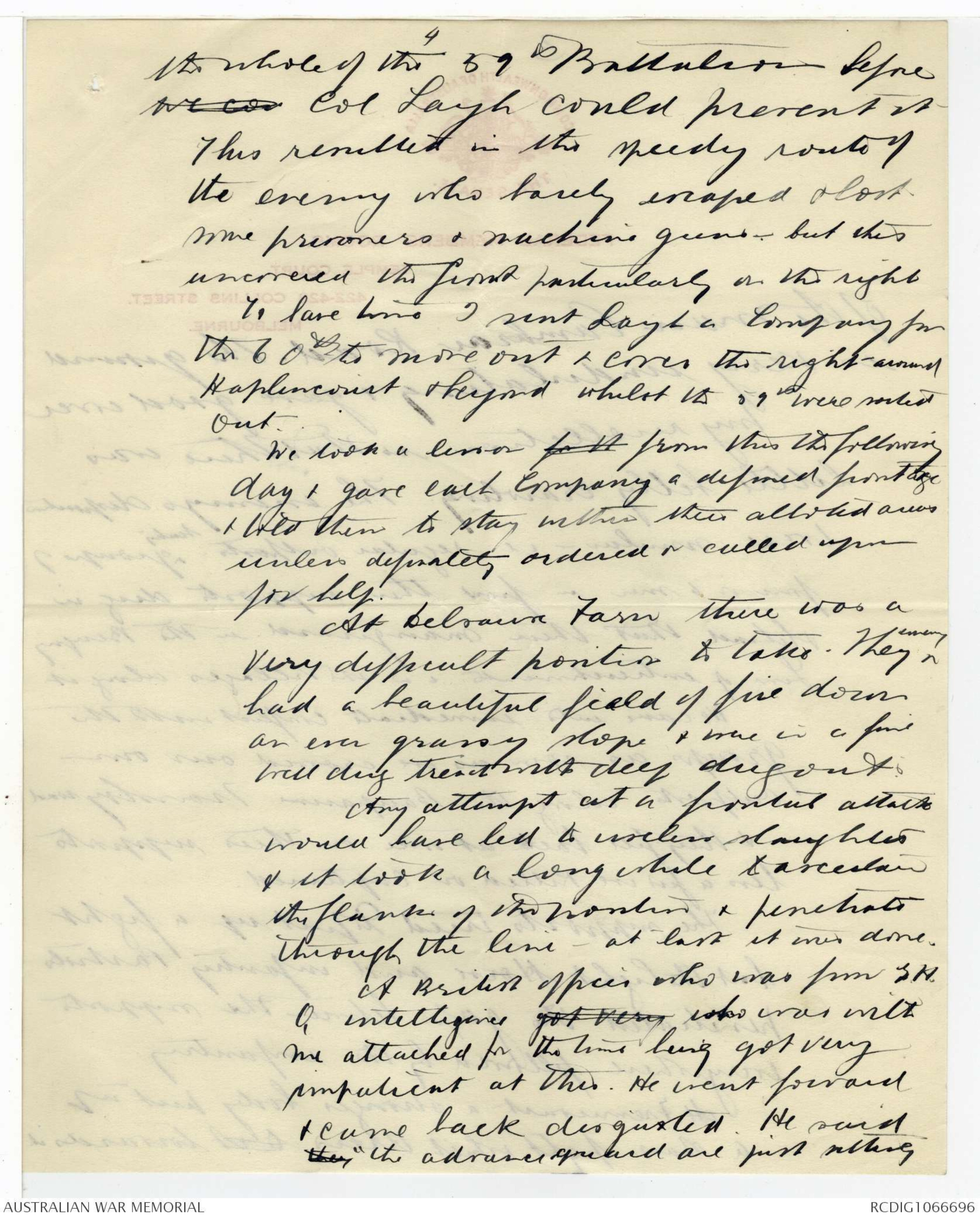
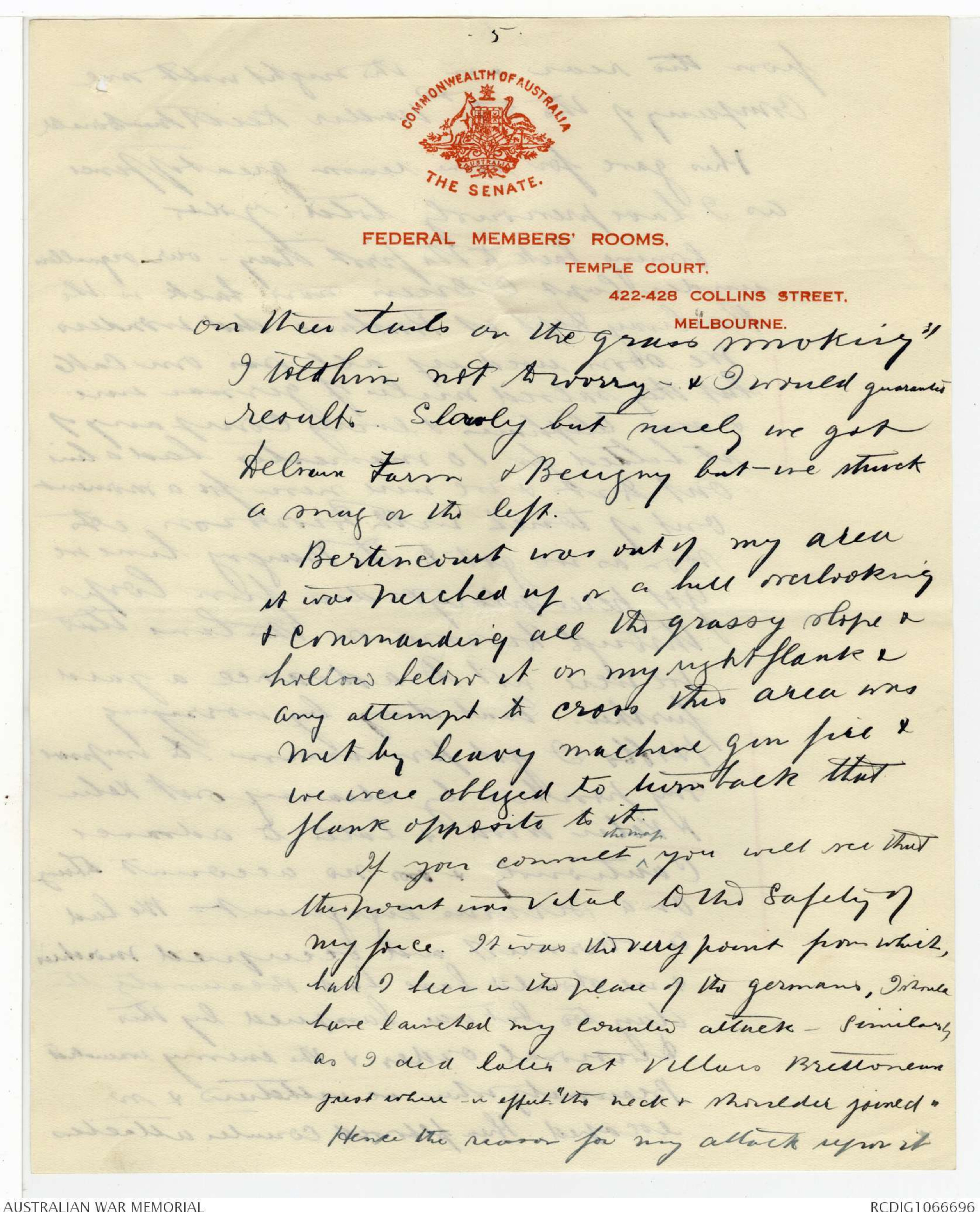
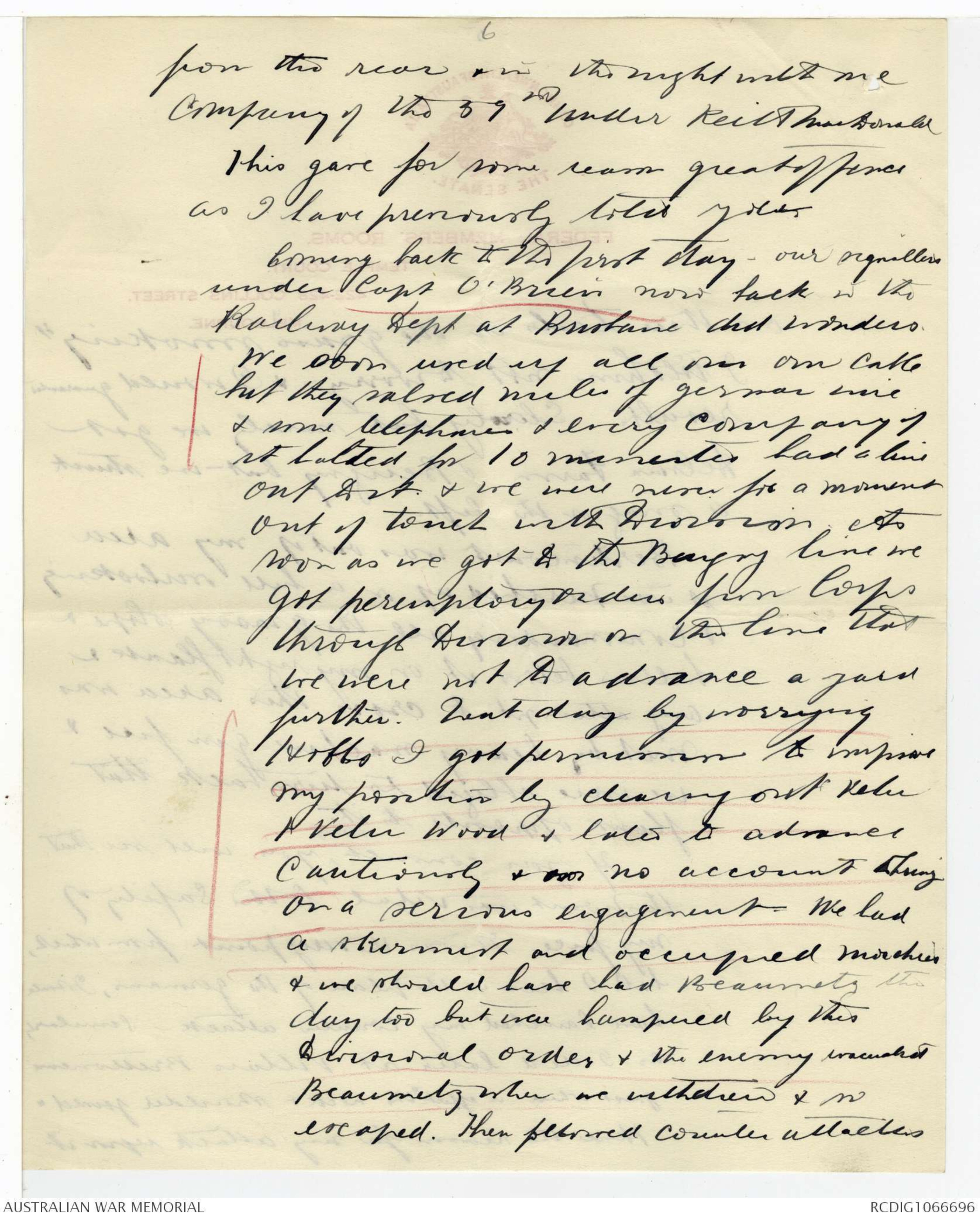
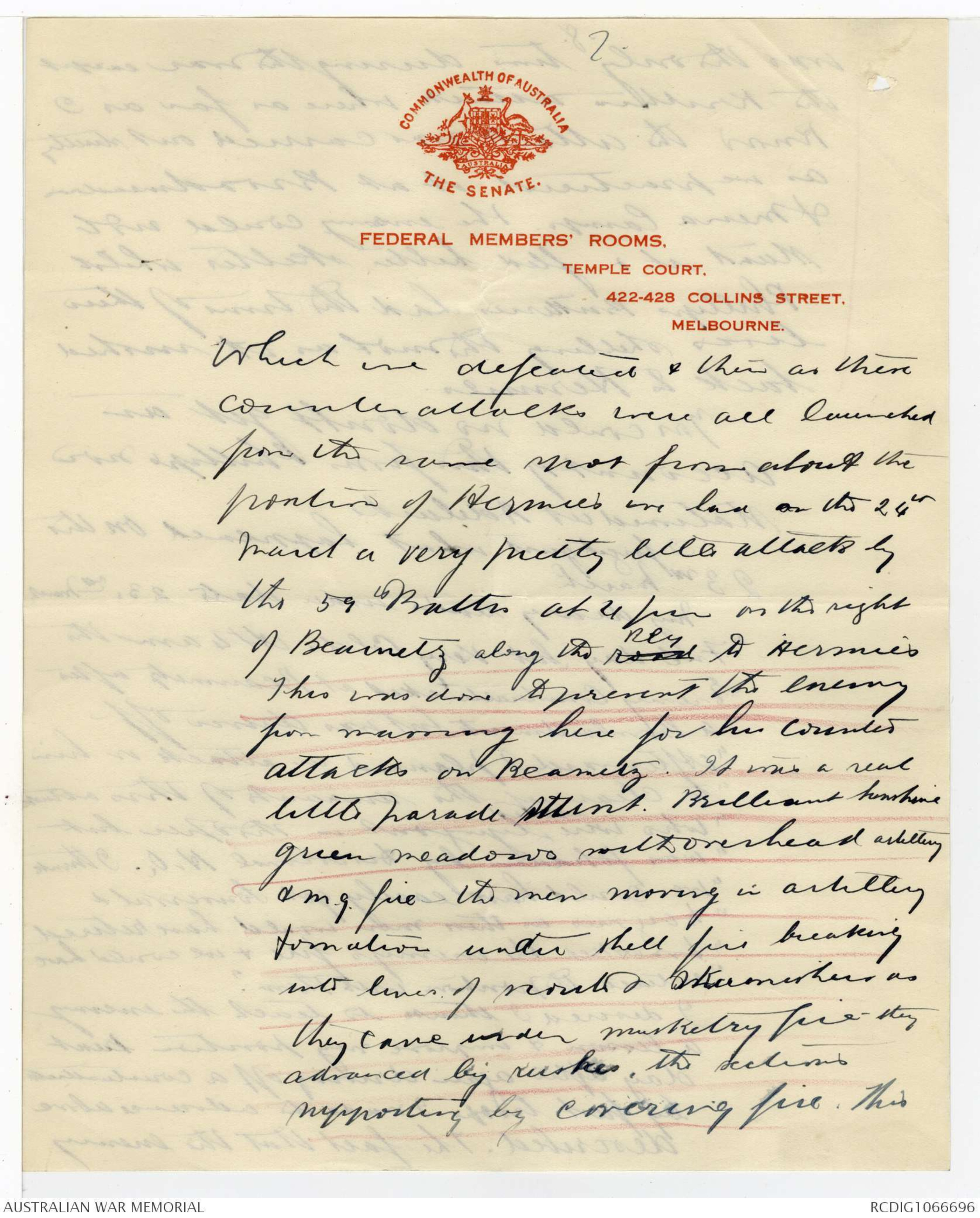
[*HN.*]
T/FMG.
TELEPHONE NOs.
F 2597.
F 2598.
COMMUNICATIONS TO BE ADDRESSED TO
"THE DIRECTOR".
IN REPLY PLEASE QUOTE
No.......
COMMONWEALTH OF AUSTRALIA.
TELEGRAPHIC ADDRESS
"AUSWARMUSE."
AUSTRALIAN WAR MEMORIAL,
POST OFFICE BOX 214 D.
EXHIBITION BUILDINGS, MELBOURNE
7th June, 1929.
"They gave their lives. For that public gift they
received a praise which never ages and a
tomb most glorious - not so much the tomb in
which they lie, but that in which their fame
survives, to be remembered for ever when occasion
comes for word or deed. . . . . "
Dear Mr. Bean,
General Elliott has recently been making available to
the War Memorial a number of war records. The main records
refer to the fighting at Polygon Wood and around Villers
Bretonneux. These records will of course be filed and will in
due course come to your notice.
Some of the records deal with the South African War
and other events prior to the Great War. I was at a loss how
to deal with these owing to the fact that, the War Memorial
collections being limited to the Great War, our system of
classification, etc. does not provide for records outside our
limited scope. I came to the conclusion that the best plan
would be to open a biographical file in General Elliott's name
and place these records there. I have informed him of this
because, as you know, some Senators and others are of the
opinion that the War Memorial should be extended to include
campaigns other than the Great War, and I felt it was desirable
that General Elliott should know that we are bound in this way.
Amongst the pre-Great War records was a criticism by
General White of General Elliott's dispositions in a tactical
scheme carried out in 1912. A copy of this is attached.
It appeared to me that it might be advisable to let you know
of this as, in forwarding it, General Elliott explained :-
"He (General (then Major) White) differed from me
in my proposed handling of an advanced Guard when
directing a Tactical scheme. I carried my
principles into action with extreme success during
March 1917 when I commanded an Advanced Guard
beyond Bapaume."
Yours sincerely,
JL Treloar
Mr. C. E. W. Bean,
Official Historian,
Victoria Barracks,
PADDINGTON, N.S.W.
(COPY).
"I dont like yr. idea of envelopmt. & letting yr.
main body push in at the centre for two reasons :-
(1) An adv. guard shd. try to avoid the necessity of
deploying the main body;
(11) If a rear guard comdr. is skilfully disposed and an
infy. adv. guard trys to outflank him the consequent
loss of time is playing into the hands of the rear
guard comdr. - He will soon learn that he has only
to stretch himself out to get you to go wide and
that wd. prob. give him all the time he wants.
With L.H. in fair strength in the adv. guard this
considn. does not apply with equal force."
(Initialed) C.W.
FL. 4151.
xxxxxxxxxx
4692.
30 July 1929.
Major-General H. E. Elliott,
C.B., C.M.G., D.S.O., D.C.M., V.D.,
44, Queen Street,
Melbourne. C.1.
Dear General,
I have been describing the fine advance of
your column from Bapaume in 1917, but the description would
be much improved if one could relate not merely that the
flanking companies "moved round" Fremicourt, Delsaux Farm,
and Beaumetz, but how that movement was carried out, e.g.,
was it a general advance, the companies moving forward
extended in successive lines of platoons (if so, how widely
extended)? etc What were the experiences of men and officers?
Did it become necessary to adopt section rushes with covering
fire, or was this done in some places where the fire was hot?
Did the line facing the enemy posts creep forward on its
bellies? And so on.
I know that it is a long time after the events for
such recollections, but some of your officers may remember
enough to say which of these ^ or other tactics was adopted on each of
these three occasions. If so, I would be grateful if you
could obtain me any particulars, or put me in touch with
anyone who can. I have written also to Colonels Layh and
Wieck, Major Legge, and several others.
Another point that requires clearing is the counter-
attack ordered on the morning of March 23rd against Doignies
and Louverval, and cancelled by the division. According to
the records, the orders for this went out before the division
was informed, and the message later sent to division is at
variance with the brigade order received by the battalions
and the artillery. There seems also to have been in
existence an order ^ from General Hobbs that the column was not to advance farther
without instructions from him.
Yours sincerely,
COMMONWEALTH OF AUSTRALIA
THE SENATE.
FEDERAL MEMBERS' ROOMS.
TEMPLE COURT.
422-428 COLLINS STREET.
MELBOURNE.
1.8.29
Dear Capt Bean,
Your letter of the 30th July to hand.
As it happens I have a good deal of the
material required at hand. Some
little time back I gave a lecture to
some of the Citizen Force Officers on the
principles of Advance Guard Work
& I have still the notes by me.
I am having Col Layh
in to lunch tomorrow and we will
go through these notes together &
let you have the result. My own recollection
is that the Screen was formed by the Light
Horse Squadron under Capt MacIntyre
with patrols in diamond formation
As the ground covered was so extensive
& touch had to be kept on each flank (our
front was about 4 miles) this screen was
very light & was therefore supplemented
by infantry patrols of the 59th Battn
who moved in a similar formation
2
with connecting files back to their
Supports & these followed in artillery
formation. The above comprised the Van
Guard under Col. Layh. I also attached
to him a few of the 18th Machine Gun Coy.
under Muirson.
The following sketch will give you a
rough idea of the Scheme
Diagram - see original document
This representation is
largely diagramatic
as it was left to the patrol
leaders how they moved
their men & naturally
they varied their formation
to meet the ground.
There was thus two Companies
of the Van guard on each side of
3
COMMONWEALTH OF AUSTRALIA
THE SENATE.
FEDERAL MEMBERS' ROOMS.
TEMPLE COURT.
422-428 COLLINS STREET.
MELBOURNE.
of the main Cambrai Road. The ground
is very undulating & gave good cover
My recollection is that there was
little belly crawling. The enemys disposition
were similar - i.e. regular outposts. ^ sentry groups of
four or 6 men in front then supports dug in
& behind that their main guard in the Berigny
Line of entrenchments & in the villages along it.
We came into immediate conflict with the
groups as soon as we crossed our own
outposts along the Baupaume Transloy road
& they fell back at once on their supports
less a few we killed or captured.
The supports tried to put up a fight
but the Light Horse and infantry patrols
penetrated the gaps between the supports
everywhere followed by the infantry.
At Fremicourt a stronger body put up
a sharp fight which drew to it towards it
4
the whole of the 59th Battalion before we co Col Layh could prevent it
This resulted in the speedy route of
the enemy who barely escaped & lost
some prisoners & machine guns - but this
uncovered the front particularly on the right
To save time I sent Layh a Company from
the 60th to move out & cover the right - around
Haplincourt & beyond whilst the 59th were sorted
out.
We took a lesson for th from this the following
day & gave each Company a defined frontage
& told then to stay within their alloted areas
unless definately ordered or called upon
for help.
At Delsaux Farm there was a
very difficult position to take. They ^ enemy
had a beautiful field of fire down
an even grassy slope & one in a fine
well dug trench with deep dugout.
Any attempt at a frontal attack
would have led to useless slaughter
& it look a long while to ascertain
the flank of the position & penetrate
through the line - at last it was done.
A British officer who was from GHQ
intelligence got very who was with
me attached for the time being got very
impatient at this. He went forward
& came back disgusted. He saidthey "the advance guard are just sitting
.5.
COMMONWEALTH OF AUSTRALIA
THE SENATE.
FEDERAL MEMBERS' ROOMS.
TEMPLE COURT.
422-428 COLLINS STREET.
MELBOURNE.
on their tails on the grass smoking"
I told him not to worry - & I would guarantee
results. Slowly but surely we got
Delsaux Farm & Berigny but we struck
a snag on the left.
Bertincourt was out of my area
it was perched up on a hill overlooking
& commanding all the grassy slope &
hollow below it on my right flank &
any attempt to cross this area was
met by heavy machine gun fire &
we were obliged to turn back that
flank opposite to it.
If you consult ^ the map you will see that
this point was vital to the safety of
my force. It was the very point from which,
had I been in the place of the germans, I should
have launched my counter attack - Similarly
as I did later at Villers Bretonneux
just where in effect "the neck & shoulder joined"
Hence the reason for my attack upon it
6
from the rear & in the night with one
Company of the 59th under Keith MacDonald
This gave for some reason great offence
as I have previously told you.
Coming back to the first day - our signallers
under Capt O’Brien now back in the
Railway Dept at Brisbane did wonders.
We soon used up all our own cable
but they salved miles of german wire
& some telephones & every Company of
it halted for 10 minutes had a line
out to it & we were never for a moment
out of touch with Division. As
soon as we got to the Berigny line we
got peremptory orders from Corps
through Division on the line that
we were not to advance a yard
further. Next day by worrying
Hobbs I got permission to improve
my position by clearing out Velu
& Velu Wood & later to advance
cautiously & on no account to bring
on a serious engagement. We had
a skirmish and occupied Morchies
& we should have had Beaumetz this
day too but were hampered by this
Divisional order & the enemy evacuated
Beaumetz when we withdrew & so
escaped. Then followed counter attacks
7.
COMMONWEALTH OF AUSTRALIA
THE SENATE.
FEDERAL MEMBERS' ROOMS.
TEMPLE COURT.
422-428 COLLINS STREET.
MELBOURNE.
which we defeated & then as these
counter attacks were all launched
from the same spot from about the
position of Hermies we had on the 24th
March a very pretty little attack by
the 59th Battn at 4 pm on the right
of Beaumetz along the road Rly to Hermies
This was done to prevent the enemy
from massing here for his counter
attacks on Beametz . It was a real
little parade stunt. Brilliant sunshine
green meadows with overhead artillery
& m.g. fire - the men moving in artillery
formation under shell fire breaking
into lines of scouts & skirmishers as
they came under musketry fire - they
advanced by rushes, the sections
supporting by covering fire. This
 Sam scott
Sam scottThis transcription item is now locked to you for editing. To release the lock either Save your changes or Cancel.
This lock will be automatically released after 60 minutes of inactivity.